As decisions on climate change adaptation involve stakeholders with different values, beliefs and attitudes (VBA), decision outcomes depend on how stakeholders interact and how power is distributed. In this paper, we explore the VBA of stakeholders involved in three water management projects focusing on dams, micro-reservoirs, or wetlands in a Peruvian watershed facing droughts. We apply a framework with the core ideas of the hydrosocial cycle, the decision context perspective, and the VBA hierarchy to show how stakeholders’ perspectives and power influence practices on the ground. The analysis of VBA reveals three different perspectives on water management held by different stakeholder groups. First, a community-based perspective, frequent among local communities, favors micro-reservoirs managed by communities. Second, an infrastructure-based perspective, frequent among public sector stakeholders, shows a preference for dams managed by the private sector. Third, a nature-based perspective, with a preference for wetlands managed by the public sector, is found across stakeholder groups. In the three water management projects, different power distributions determine which VBA dominate and influence practices on the ground. Dams on the ground represent power from the public and private sectors, while micro-reservoirs represent local grassroot control. In the wetland project, the outcomes of the evolving hydrosocial cycle are still unclear and will depend on how multiple perspectives are considered. Examining and questioning the decision context in which adaptation occurs can help excluded stakeholders achieve more power and agency and tackle the fundamental question of ‘adaptation of what and for whom’.
DOI:
https://doi.org/10.1016/j.envsci.2022.08.002
Skor altmetrik:
Jumlah Kutipan Dimensi:



















